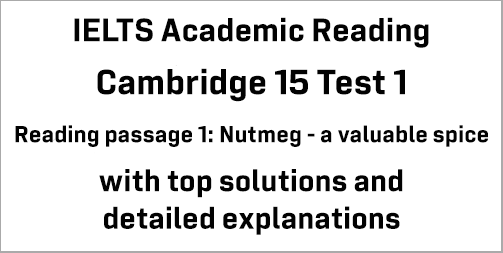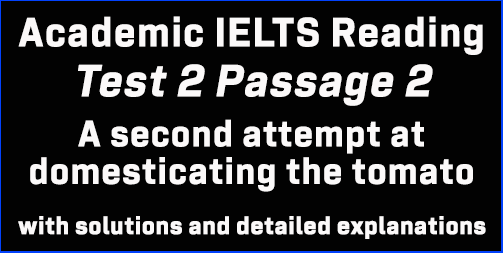IELTS Academic Reading: Cambridge 15 Test 1 Reading passage 1; Nutmeg – a valuable spice; with best solutions and top explanations
This Academic IELTS Reading post focuses on solutions to IELTS Cambridge 15 Reading Test 1 Reading Passage 1 entitled ‘Nutmeg – a valuable spice’. This is a targeted post for IELTS candidates who have major problems finding out and understanding Reading Answers in the AC module. This post can guide you the best to understand every Reading answer without much trouble. Finding out IELTS Reading answers is a steady process, and this post will assist you in this respect.
IELTS Cambridge 15 Test 1: AC Reading Module
Reading Passage 1: Questions 1-13
The headline of the passage: Nutmeg – a valuable spice
Questions 1-4: Completing notes:
[In this type of question, candidates are asked to complete different notes with ONE WORD ONLY from the passage. Keywords are important to find answers correctly. Generally, this type of question maintains a sequence. However, we should not be surprised if the sequence is not maintained. Find the keywords in the passage and you are most likely to find the answers.]
Title of the note: The nutmeg tree and fruit
Question no. 1: the leaves of the tree are ________ in shape
Keywords for the question: leaves, shape,
For this question, we have to look at the first paragraph, as this paragraph describes the nutmeg tree and its fruit in detail. Let’s have a look. Lines 3-4 say, “ .. . . The tree is thickly branched with dense foliage of tough, dark green oval leaves, . .. .. .”
This means the shape of the nutmeg tree leaves is oval.
So, the answer is: oval
Question no. 2: the ________ surrounds the fruit and breaks open when the fruit is ripe
Keywords for the question: surrounds the fruit, breaks open, ripe,
Lines 5-6 of paragraph no. 1 say, “ . .. . The fruit is encased in a fleshy husk. When the fruit is ripe, this husk splits into two halves along a ridge running the length of the fruit. . .. .”
Here, encased in = surrounded by / covered in, splits into two halves = breaks open,
So, the answer is: husk
Question no. 3 & 4:
- the ________ is used to produce the spice nutmeg
Keywords for the question: used to produce, spice nutmeg,
- the covering known as the aril is used to produce ________
Keywords for the question: covering, known as the aril, used to produce,
The answers to these two questions can be found in the last few lines of paragraph no. 1. The writer of the passage says in lines 6-9, “ . .. . Inside is a purple-brown shiny seed, 2–3 cm long by about 2 cm across, surrounded by a lacy red or crimson covering called an ‘aril’. These are the sources of the two spices nutmeg and mace, the former being produced from the dried seed and the latter from the aril.”
Here, the former indicates to seed, the latter indicates to mace.
These lines suggest that the spice nutmeg is produced from the seed of the nutmeg tree. Also, the covering of the seed, which is known as ‘the aril’ is used to produce mace, which is another spice.
So, the answers are:
- seed
- mace
Questions 5-7: TRUE, FALSE, NOT GIVEN
[In this type of question, candidates are asked to find out whether:
The statement in the question agrees with the information in the passage – TRUE
The statement in the question contradicts with the information in the passage – FALSE
If there is no information on this – NOT GIVEN
For this type of question, you can divide each statement into three independent pieces and make your way through with the answer.]
Question no. 5: In the Middle Ages, most Europeans knew where nutmeg was grown.
Keywords for the question: Middle Ages, most Europeans, knew, where, nutmeg, grown,
To find the answer to this question, we have to find the keyword ‘Middle Ages’. In the second paragraph, the first line contains the keyword ‘Middle Ages’. Let’s read there. “Nutmeg was a highly prized and costly ingredient in European cuisine in the Middle Ages, and was used as a flavouring, medicinal, and preservative agent. Throughout this period, the Arabs were the exclusive importers of the spice to Europe. They sold nutmeg for high prices to merchants based in Venice, but they never revealed the exact location of the source of this extremely valuable commodity. .. ..”
The lines suggest that the Arabs were the exclusive exporters of nutmeg to Europe. But they never revealed, or, told anyone about the location of this spice tree. So, most Europeans knew nothing about the location of the nutmeg tree.
So, the answer is: FALSE
Question no. 6: The VOC was the world’s first major trading company.
Keywords for the question: VOC, world’s first, major trading company,
We find out about the VOC in paragraph no. 4. Here, the writer says, “In 1602, Dutch merchants founded the VOC, a trading corporation better known as the Dutch East India Company. By 1617, the VOC was the richest commercial operation in the world. The company had 50,000 employees worldwide, with a private army of 30,000 men and a fleet of 200 ships. . .. .”
Here, the writer admits that by 1617, the VOC became the world’s richest commercially operating company. However, the paragraph contains no information on whether the VOC was the world’s first major trading company or not.
So, the answer is: NOT GIVEN
Question no. 7: Following the Treaty of Breda, the Dutch had control of all the islands where nutmeg grew.
Keywords for the question: Following, Treaty of Breda, the Dutch, control, all the islands, nutmeg grew,
We can find about the Treaty of Breda in paragraph no. 5. Have a close look at lines 11-17, “ . .. . After decades of fighting for control of this tiny island, the Dutch and British arrived at a compromise settlement, the Treaty of Breda, in 1667. Intent on securing their hold over every nutmeg-producing island, the Dutch offered a trade: if the British would give them the island of Run, they would in turn give Britain a distant and much less valuable island in North America. The British agreed. That other island was Manhattan, which is how New Amsterdam became New York. The Dutch now had a monopoly over the nutmeg trade which would last for another century.”
Here, we can find out that the British Empire signed the Treaty of Breda in 1667 with the Dutch and gave away the island of Run to the Dutch. After the signing of the treaty, the Dutch gained complete control, or, monopoly business of nutmeg of all the islands where nutmeg grew.
So, the answer is: TRUE
Questions 8-13: Completing table: ONE WORD ONLY
[In this type of question candidates need to fill in the gaps in a table with ONE WORD ONLY. Skimming and scanning, both reading skills are essential for this question-type.]
Question no. 8: Middle Ages: Nutmeg was brought to Europe by the _______
Keywords for the question: Middle Ages, Nutmeg, brought to Europe, by,
We’ve already looked at the information for question no. 5. Lines 1-3 of paragraph no. 2 says, “Nutmeg was a highly prized and costly ingredient in European cuisine in the Middle Ages, and was used as a flavouring, medicinal, and preservative agent. Throughout this period, the Arabs were the exclusive importers of the spice to Europe. .. .”
Here, exclusive importers of the spice to Europe = the spice brought to Europe by,
So, the answer is: Arabs
Question no. 9: 17th Century: Demand for nutmeg grew, as it was believed to be effective against the disease known as the _________
Keywords for the question: 17th Century, Demand, grew, believed, effective against, disease, known as,
Paragraph no. 4 begins with the year 1602, which indicates to the 17th Century.
In paragraph no. 4, take a look at lines 4-6, “ . .. . At the same time, thousands of people across Europe were dying of the plague, a highly contagious and deadly disease. Doctors were desperate for a way to stop the spread of this disease, and they decided nutmeg held the cure. Everybody wanted nutmeg, and many were willing to spare no expense to have it. .. ..”
Here, nutmeg held the cure = nutmeg was believed to be effective against plague.
So, the name of the disease was the plague.
So, the answer is: plague
Question no. 10: 17th Century: The Dutch – put ________ on nutmeg to avoid it being cultivated outside the islands.
Keywords for the question: 17th Century, the Dutch, put, on nutmeg, to avoid, being cultivated, outside the islands,
In paragraph no. 5, let’s take a look at lines 7-9, “ . .. In addition, all exported nutmeg was covered with lime to make sure there was no chance a fertile seed which could be grown elsewhere would leave the islands. . .. .”
Here, nutmeg was cover with lime = lime was put on nutmeg, make sure there was no chance a fertile seed which could be grown elsewhere = avoid it being cultivated outside the islands,
This means the Dutch used to put lime on nutmeg to make the seed of nutmeg infertile so that the cultivation of nutmeg could be avoided elsewhere.
So, the answer is: lime
Question no. 11: 17th Century: The Dutch – finally obtained the island of _______ from the British.
Keywords for the question: 17th Century, the Dutch, finally obtained, the island, from the British,
At the end of paragraph no. 5, the writer says in lines 9-15, “… .. . There was only one obstacle to Dutch domination. One of the Banda Islands, a sliver of land called Run, only 3 km long by less than 1 km wide, was under the control of the British. After decades of fighting for control of this tiny island, the Dutch and British arrived at a compromise settlement, the Treaty of Breda, in 1667. Intent on securing their hold over every nutmeg-producing island, the Dutch offered a trade: if the British would give them the island of Run, they would in turn give Britain a distant and much less valuable island in North America. The British agreed.”
Here, this account of history suggests that following the Treaty of Breda in 1667, the Dutch finally obtained the island of Run from the British.
So, the answer is: Run
Question no. 12: Late 18th Century: 1770 – nutmeg plants were secretly taken to _______
Keywords for the question: Late 18th Century, 1770, nutmeg plants, secretly taken to,
The first lines on paragraph no. 6 give us the answer to this question. The writer of the passage says here, “Then, in 1770, a Frenchman named Pierre Poivre successfully smuggled nutmeg plants to safety in Mauritius, an island off the coast of Africa. .. ..”
Here, smuggled = secretly taken,
So, the answer is: Mauritius
Question no. 13: Late 18th Century: 1778 – half the Banda Islands’ nutmeg plantations were destroyed by a ________.
Keywords for the question: Late 18th Century, 1778, half, Banda Islands’ nutmeg plantations, destroyed by a,
In paragraph no. 6, lines 3-4 say, “ . .. . Next, in 1778, a volcanic eruption in the Banda region caused a tsunami that wiped out half the nutmeg groves. .. ..”
Here, wiped out = were destroyed, nutmeg groves = nutmeg plantations,
So, the answer is: tsunami
Click here for solutions to Cambridge 15 AC Test 1 Reading Passage 2
Click here for solutions to Cambridge 15 AC Test 1 Reading Passage 3




i love this explanation, thank you